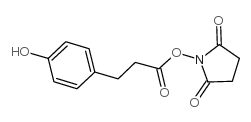| Structure | Name/CAS No. | Articles |
|---|---|---|
 |
Benzenepropanoic acid,4-hydroxy-, 2,5-dioxo-1-pyrrolidinyl ester
CAS:34071-95-9 |
D P McManus, D J McLaren, N W Clark, R M Parkhouse
Index: J. Helminthol. 61 , 47-52, (1987)
Full Text: HTML
Living, intact protoscoleces of the British horse and sheep strains of Echinococcus granulosus were subjected to surface radioiodination procedures using 125I and Iodogen and 125I-Bolton Hunter reagent. Subsequent combined electron microscopy and autoradiography revealed specific surface membrane labelling with the Iodogen procedure, but significant tegumental labelling with the Bolton-Hunter reagent. The two parasite strains yielded different profiles of electrophoretically separated labelled proteins; the Iodogen method, not surprisingly, resulted in a less complex pattern of labelled polypeptides than the Bolton and Hunter reagent.
| Structure | Name/CAS No. | Molecular Formula | Articles |
|---|---|---|---|
 |
Benzenepropanoic acid,4-hydroxy-, 2,5-dioxo-1-pyrrolidinyl ester
CAS:34071-95-9 |
C13H13NO5 |
|
Tumor-targeted delivery of paclitaxel using low density lipo...
2015-04-06 [Mol. Pharm. 12(4) , 1230-41, (2015)] |
|
Diabody Pretargeting with Click Chemistry In Vivo.
2015-09-01 [J. Nucl. Med. 56 , 1422-8, (2015)] |
|
Appendix: Preparation of N-succinimidyl 3-(4-hydroxyphenyl)p...
1973-07-01 [Biochem. J. 133 , 538, (1973)] |
|
The labelling of proteins to high specific radioactivities b...
1973-07-01 [Biochem. J. 133 , 529-539, (1973)] |
|
Radioiodination and biodistribution of quantum dots using Bo...
2011-01-01 [Appl. Radiat. Isot. 69 , 56-62, (2011)] |
Home | MSDS/SDS Database Search | Journals | Product Classification | Biologically Active Compounds | Selling Leads | About Us | Disclaimer
Copyright © 2024 ChemSrc All Rights Reserved